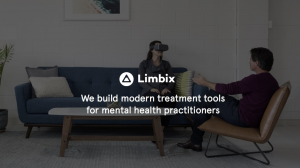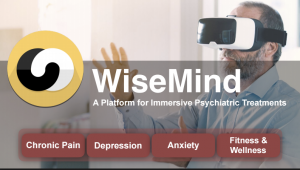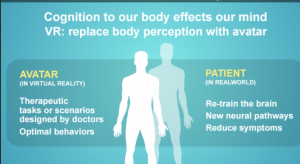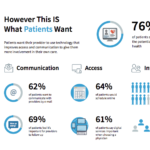HTF SF 8/23 Recap: Virtual Reality and Blockchain in Mental Health
This post highlights key takeaways from the presentations at the latest HTF SF chapter event.
According to the WHO, one in four people will be affected by mental health disorders in their lives. And nearly two thirds of those people will not seek help, because of the challenges to finding a therapist.
Stigma is a big reason why mental health is so debilitating. When people are at their most vulnerable state, they often times also feel the most ashamed to talk to people close to them. This puts them in a position outside of their inner social circles when they need support most and means those who need help actually become alienated and are often not getting the support necessary.
56% of Americans with mental illnesses are not receiving treatment. Luckily, innovation is beginning to pick up in the mental health space and entrepreneurs are working to innovate treatments that may help remove some of the stigma with mental health through engaging and novel technologies such as virtual reality.
At the latest HTF SF event at Hogan Lovells, entrepreneur speakers share their perspective on how their company is tackling mental health with VR, and we get a look at the implications of blockchain for healthcare from one of Hogan Lovells’ rising stars.
Limbix
Jon Sockell, co-founder and Director of Marketing at Limbix, presents the modern treatment tools for virtual reality exposure therapy, CBT and mindfulness that his company is building.
Limbix is a company working to expand the treatment tools available to therapists beyond just paper and pens. Jon and his team are building a platform to augment treatment sessions and help therapists use virtual reality exposure therapy to help their patients. VR therapy has been going on for 20 years, and there is a growing body of scientific research supporting it. VR therapy brings life-like stimulus into the a safe contextual experience where patients can overcome phobias and traumas using exposure therapy.
When his team set out to speak with practitioners, psychiatrists and psychologists asked them to build something to help patients do at-home therapeutic exercises (homework) and a repository to track the assignments.
Limbix gives therapists the control necessary to graduate the exposure to treat traumas and phobias. Therapists can expose patients to a triggering stimuli such as a war zone, accident scene, heights, etc. and then help them cope safely within their clinics. This is much more practical than physically bringing the patient to the stimuli and expands the scope of what is possible within a typical session.
 Patients who have been involved in traumatic car accidents can gradually be reintroduced to triggering stimuli via exposure therapy.
Patients who have been involved in traumatic car accidents can gradually be reintroduced to triggering stimuli via exposure therapy.
Limbix also provides a dashboard for assigning homework to patients, thought recording, managing medications and reporting outcomes online. This gives both patients and therapists easy access and control to all info on one convenient platform, and enables patient autonomy:
Private practices trying to differentiate themselves in the market have been very receptive to trying the technology. Limix launched in July of this year and has already signed on hundreds of therapists onto their platform.
For more information or updates, follow their blog.
KARUNA
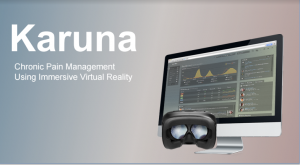 Dr. Sharon Niv is the co-founder and Chief Scientific Officer at Karuna, a company using immersive VR to manage chronic pain.
Dr. Sharon Niv is the co-founder and Chief Scientific Officer at Karuna, a company using immersive VR to manage chronic pain.
There is a large psychological component to chronic pain, and understanding how to address both psychological and physiological factors are integral parts of a holistic pain management strategy.
Karuna is a company creating a virtual reality platform to manage chronic pain.
Chronic pain originates in the central nervous system, and often endures after an injury heals. The body overweighs stimulus in certain area of body as bigger and more loud than other parts of body, resulting in reduction of pain-free range of motion.
Another common occurrence of chronic pain is phantom limb pain. This occurs when the brain a limb interprets stimuli from link that doesn’t exist anymore, and takes stimuli from a similar area of the body.
A technique called mirror visual feedback is commonly used to treat phantom limb pain, and patient can undergo various exercises to see representations of what they want to see (uncurl fingers, shake out a hand that is no longer there). This “tricks” the brain into thinking the missing limb has moved and will ease some of the pain:
Mirror Visual Feedback for phantom limb pain.
Embodiment
Turns out, our brain is not completely identified with our body. It’s actually fairly flexible with what it wants to be identified with (due to mirror neurons), and can be embodied to different things like an avatar in VR. Patients can see their injured limbs moving in a virtual environment, and this replaces Mirror Visual Feedback therapy in the real world. Since visual input is the most dominant stimuli for the brain, manipulating what we see will have a profound impact on how the brain responds.
With virtual reality, we no longer need the mirror visual feedback, and instead can use embodiment in VR to offer a first-person perspective that is much more immersive and powerful for patients.
Why This Works
The human brain uses visual input to override other input, and this balances out the disagreement for the efferent sensory system that causes phantom limb pain. For example, the brain sends out a signal and the response doesn’t match because limb doesn’t declutter itself.
Using a biopsychosocial approach (symptom tracking, meditation, VR), Karuna is able to operate as a significant intervention for chronic pain. The company plans to continue using an evidence-based approach to treat patients.
Looking Ahead
Practitioners are very open to using Karuna’s technology. And due to the opioid crisis, the search for alternative treatments will only grow. So far, there haven’t been pushback on CPT codes Karuna is using to be reimbursed, and they plan to get their own CPT codes eventually.
As VR hardware prices keep dropping and software advances, we can expect wireless VR experiences to become possible so it’s more convenient for patients. Lower back tracking will also become easier and we will see chronic pain management improve with time.
For more information, take a look at the Karuna blog.
Fangwei Lee is the co-founder and CEO of Realiteer, a company fighting mental illness with innovative software technologies. He presented the WiseMind platform, one of the products in Realiteer’s portfolio. Fangwei brings a unique background of animation and computer science into the mental health space, having worked as the visual lead at Dreamworks Animation for projects such as Madagascar.
The national average is a 1.5 month wait to see a doctor. The waiting list is long, quality service is not readily accessible, and patients don’t like therapy homework so engagement is low. Over-the-counter, and the efficacy of self-help books are not verified by therapists.
In short, people in need are not properly treated, and often times those who are treated have low engagement.
So Fangwei and his team created the WiseMind platform to become a one-stop shop for mental health treatment. The platform is installed in clinics, phones and computers. This connective ecosystem allows for psychotherapy treatments every day and users can share thoughts and experiences through online commentary:
Realiteer has been working on this platform since 2015 and has released seven mental health VR apps with over 600k downloads and 4.2 + ratings in their portfolio. On the clinical side, there have been large improvements in clinical improvements and patients getting better in clinical conditions. His company also uses the concept of embodiment to treat patients, and use cases include addiction therapy and phobia management.
Patients can manipulate their avatar in virtual reality and form neural pathways which will benefit them in the real world. WiseMind’s story engine also allows therapists to record procedures that patients can access at the clinic or at home to increase engagement.
 Embodiment treatment example: Immersive Exposure for Alcoholism.
Embodiment treatment example: Immersive Exposure for Alcoholism.
WiseMind is currently working to simulate gravity and integrate a real feel of “touch” into their platform to expand the use cases to other forms of therapies.
For more information about the other projects Realiteer is working on, take a look at their portfolio.
Blockchain in Mental Health
In addition to a discussion on VR in mental health, Gabe Shapiro, a cryptocurrency enthusiast and rising star at Hogan Lovells, gives a presentation on implications of blockchain in healthcare.
Blockchain is a new technology that has garnered a lot of recent media attention. It has mostly been spoken of in the context of a decentralized currency, but there may be possible applications for healthcare.
Here are a few key takeaways that Gabe shared about blockchain:
- It is a protocol (like HTTPS back in ‘91). Ultimately the network arrives at an answer that everyone on network will honor
- Facilitates transactions (i.e. practitioner-patient)
- No central authority is involved (peer-to-peer system, high level of security)
Smart Contracts
Smart contracts are self-enforcing contracts that can be coded to execute when specified conditions are met. For places that lack trust in the legal systems or between individuals, this technology provides a self-enforcing contract and trustless transactional capabilities:
Use cases for Healthcare?
Therapist are required to report ongoing domestic violence. For domestic abuse victims who are in need of treatment but want to remain anonymous so their partner does not go to jail, blockchain allows both parties to participate without compromising their own interests.
Patients who can pay in cryptocurrency can email therapist description of issues and therapists can respond with follow-up questions, a diagnosis and actionable items. Though this may still not be an ideal situation for a patient experiencing domestic violence, this opens up more possibilities available to consumers.
Challenges
Despite the benefits of a decentralized peer-to-peer system, infrastructure still needs to be build to allow different checks and balances in the system.
Blockchain enables illegal transactions (Dark Web drug trafficking) and are not well regulated. The entire program function as autonomous agents and legislature needs to evolve and adapt accordingly to the new technology.
HTF SF will be hosting its next event, Digital Health in the Pharmaceutical Industry, on 9/27 at Hanson Bridgett.

